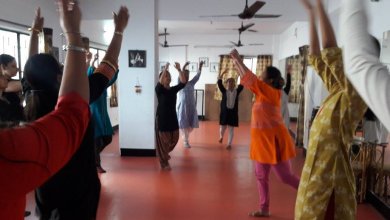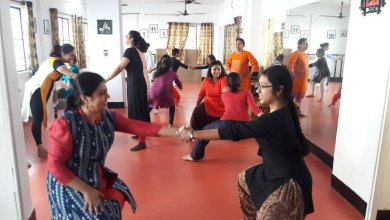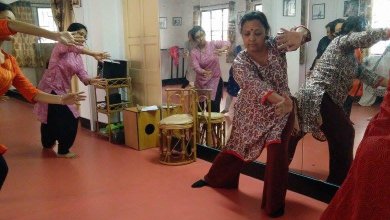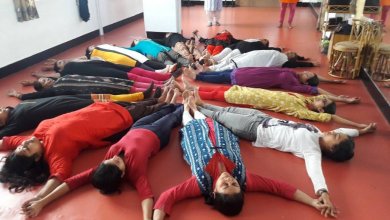
|   |

|   |
 e-mail: ukb7@rediffmail.com Stirrings and Stillness, Sounds and Silence December 17, 2016 Dance is a movement experience that takes us along a journey: with or without words. As a unique physical discipline in which emotional, psychological, spiritual, intellectual and creative energies are unified and harmonised, dance allows our bodies to feel, think, speak, memorize, express and communicate effectively through movement. Dance also liberates people's bodies and allows them to use unusual movement styles outside the limited restrictions of their daily lives. The recent workshop on Creative Movement Therapy, organised by Rhythmosaic from Kolkata and facilitated by Tripura Kashyap, co-founder of Creative Movement Therapy Association of India - and herself a noted choreographer, movement therapist and dance educator: groomed first in Kalakshetra and later in the USA - focussed on free-style movement techniques that unlock our body capacity to communicate and express better. The accent on movement was essentially non-judgmental and adapted itself to a wide variety of body types and personalities. It also helped participants to liberate from habitual movement patterns and to discover a new, dynamic body language. Pupils - from different dance disciplines - explored in the workshop their 'inner dance' enhancing self-awareness, confidence and awareness of others. Movement activities were interspersed with verbal dialogues which helped to expand and enrich the movement experiences. Participants also attempted to access their emotional expressions, release stress and enhance their range of movements while working in solos, with partners and in groups. Extracts from an interview with the facilitator: How do you characterize movement in dance in ancient and modern societies? In most ancient societies, rhythmic movement and dance were an integral part of community living. It was the common folk: like farmers, hunters, fishermen, wood-cutters and housewives who danced and sang. Dance gradually became an aesthetic adjunct of socio-cultural behavior in every society. In contemporary times, much of these have become formalized, technique bound and performance oriented. Trained instructors use specialized teaching methodologies to transmit their knowledge of dance to the next generation. In almost every country, many specific forms and styles dictate the creation of dances. For example, in classical ballet, dancers travel across space with movements that have floating and light airborne qualities. Balancing on a single leg in many ways, boundless pirouettes, partnering sequences between men and women characterize the form, among other features. In most classical Indian dances, facial expressions and stylized hand gestures accompany intricate body movements. These are further embellished by movements of the eyes and neck accompanied by rhythmic stamping of the feet. What has been Rudolf Laban's contribution to notating dance and formulating dance movement therapy? Laban was a Hungarian pioneer of modern dance theory, movement notation and analysis, and had an invaluable influence on dance therapy. Besides his extensive work in the area of examining human motion and describing it in detail, he also observed and investigated speech and conversations accompanied by movement. Other variables such as spacing or pauses between movement patterns and postural shifts during verbal conversations were also notated. Simultaneously, his colleagues scrutinized facial expressions, eye contact and shadow movements that took place in interpersonal human interactions. He notated through symbols -- similar to those used in short hand -- both the functional and expressive movements of individuals involved in performing ordinary, everyday actions. He was also able to analyze these movements and decipher the logic and meaning behind them. Dance therapy practitioners have created detailed assessment and evaluation formats to observe their clients based on what is known as 'Labanotations'. On the basis of these assessments, they study their clients' movements in greater detail and hence are able to work more effectively. This further helps them to set up treatment plans, themes and goals for their sessions. 

How has movement therapy progressed over time? Though movement therapy started off as a form of treatment for war veterans and psychiatric patients, its scope and application gradually widened to embrace people with developmental, medical, social and physical impairments. It is now also being used as a co-curricular activity in educational settings, as adjunctive therapy in hospitals, special schools, halfway homes, and treatment centres. It has been included as part of recreation and exercise programs at orphanages, old age homes and prisons. Group facilitators also use it in de-addiction centres and integrated schools (mixed groups of able and special needs children), among many other settings. How have you used movement therapy in Indian classical dance? Most Indian classical dancers use a variety of hand gestures (hastas) to express emotions and delineate stories. Before introducing these in sessions, fine motor exercises can be done to make the fingers and wrists suppler, so that articulation becomes easier. For example, opening and closing palms, wriggling, shaking, flicking, bending and stretching fingers and rotating the wrists clock and anti-clockwise, other movements can be done. Soon after this, single and double-hand gestures may be combined to craft a separate dance for the hands. The idea is similar to that of the sign language used with the hearing impaired. In workshops, learning to articulate hands through gestures invariably creates a sense of awe in most participants who would look at their hands, wrists and fingers, as if seeing them for the first time! Participants can be encouraged to employ hand gestures in a variety of ways. They may use them to converse with each other and create movement words, sentences, poems and stories through them. They may also improvise body movement in relation to a hand gesture they could hold. For example, if a person holds a fist, she can explore through improvisation how it affects the rest of the body's postures and movement. Towards the end, participants can invent their own gestures that express feelings and share stories from their own lives. How did you evolve your idea of workshop on movement therapy? Santha Kumar, a renowned psycho-therapist, and I examined together how we could use body movement to express our thoughts and emotions that are actually felt, registered and housed in our bodies. Santha perceived the existence of a body-mind continuum and acknowledged that one entity definitely influences the other. We discussed that it is within this continuum that the personality is embedded. Therefore, by having a positive relationship with our body and its movement, we could attempt to re-shape the very essence of our personality. We also discussed Eastern body awareness and movement practices that have specifically been designed to understand the inner self and psyche. These practices also say: the more self-expression there is, the greater the clarity about our lives and the less blocked we become in our personal growth. Gradually, we synthesized our understanding of dance and psycho-therapy and developed a workshop that would primarily focus on strengthening the body-mind interface through movement, art work, music and psycho-therapeutic processing. We felt excited about creating a space for people to befriend and rejoice their bodies, while experiencing the sheer joy of movement. In a workshop, what is your normal target group? We use common training tools for dancers as well as non-dancers. The problems we address are common to all, related to physiological, mental and emotional aspects. Our movement therapy applies to communities, hospitals with cardiac patients and even schizophrenics. In fact, other than dancers, our participants have been teachers, special educators, theatre people, visual artists, physical instructors and child therapists. We provide a mental challenge and try to increase their attention span up to three months, by providing a set of movement activities and games. What is the time frame you allow to achieve concrete results from your workshop? The therapy must be put to use and there is a need to practice over 6 to 9 months. We set up short-term and long-term goals and suggest specific movement capsules attuned to these goals. Are you addressing individuals or groups - what is your approach? It depends on the disability. Our approach can vary from one-to-one to one-to-many. In general, we prefer group work because we have noticed that there is always a synergy that gets formed among group members. Talking about disability, have you tackled autism? Indeed, we have. There is a strong body of theory as well as practice in movement therapy related to autism. Laban's movement analysis, supplemented by Bartecnieff principle, has led to therapeutic development for this malady. Personally, I have applied it to 180 autistic kids, which has been detailed in my book: My Body, My Wisdom - Creative Dance Therapy, Penguin, 1990. Are there others in India working in this area and what do you all cover? Yes, there are quite a few. Together, we have formed 'Creative Movement Therapy Association' and formulated courses that can last from three months to 230 hours and up to 1-5 days, depending on the choice. Given time, we teach anatomy through movement up to personal movement language. Our coverage process has basic, intermediate and advanced stages, beginning from movement building, movement exploration, movement expression, movement resolution, movement illumination, and ending with movement integration. One has to remember that dance adapts the body, as much as the body adapts dance! 

Feedback from participants: Shuvo (Odissi dancer, studied psychology at Master's level, already exposed to therapy, no corporate experience) The workshop was anti-depression and was psychologically therapeutic. It was relevant for everybody and very value-neutral. Angira (Odissi dancer, studied bio-technology at Master's level, already exposed to therapy, some corporate experience) The workshop was well balanced, with warm-up and theory. I could do my movements and carry out creative explorations on my own.  Dr. Utpal K Banerjee is a scholar-commentator on performing arts over last four decades. He has authored 23 books on Indian art and culture, and 10 on Tagore studies. He served IGNCA as National Project Director, was a Tagore Research Scholar and is recipient of Padma Shri. Post your comments Please provide your name and email id when you use the Anonymous profile in the blog to post a comment. All appropriate comments posted with name & email id in the blog will also be featured in the site. |